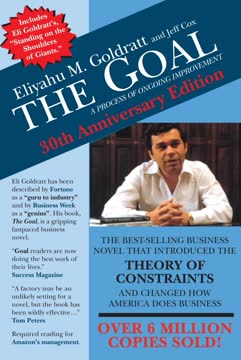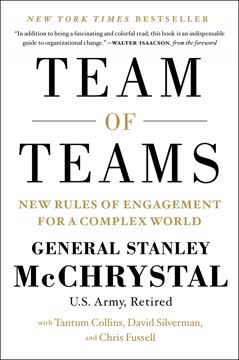Key Takeaways
1. Financial intelligence is a set of learnable skills crucial for business success
Financial intelligence boils down to four distinct skill sets, and when you finish the book, you should be competent in all of them.
Understanding financial foundations. Financial intelligence begins with grasping the basics of financial measurement. This includes reading income statements, balance sheets, and cash flow statements. It's about understanding the difference between profit and cash, and why the balance sheet balances.
Recognizing the art of finance. Finance and accounting aren't purely scientific; they involve estimates, rules, and assumptions. Financially intelligent managers can identify where these artistic aspects have been applied and how different applications might lead to different conclusions.
Analyzing financial information. With a solid foundation and appreciation for the art of finance, managers can use financial information to make better decisions. This includes understanding ratios, return on investment (ROI) analysis, and other financial tools.
Key skills:
- Reading financial statements
- Understanding financial estimates and assumptions
- Analyzing financial ratios and metrics
- Using financial information for decision-making
2. Profit is an estimate, not a concrete fact
Profit is always an estimate—and you can't spend estimates.
Revenue recognition. Profit starts with revenue, which is recorded when a product or service is delivered, not necessarily when cash is received. This means that profit can be based on promises to pay, not actual cash in hand.
Expense matching. Expenses on the income statement are matched to the revenue they help generate, not necessarily when they are paid. This can create a disconnect between profit and cash flow.
Accounting estimates. Many line items on the income statement involve estimates and judgments, such as depreciation schedules or bad debt allowances. These can significantly impact reported profit without affecting cash flow.
Factors affecting profit estimates:
- Timing of revenue recognition
- Matching of expenses to revenue
- Depreciation and amortization methods
- Allowances for bad debts
- One-time charges and write-offs
3. The balance sheet reveals more than the income statement
The balance sheet answers a lot of questions—questions like the following: Is the company solvent? Can the company pay its bills? Has owners' equity been growing over time?
Snapshot of financial health. The balance sheet provides a snapshot of a company's financial position at a specific point in time. It shows what a company owns (assets), what it owes (liabilities), and the difference between the two (equity).
Asset valuation. The balance sheet can reveal important information about how a company values its assets. This includes understanding depreciation methods, goodwill calculations, and inventory valuation techniques.
Capital structure. By examining the liabilities and equity sections of the balance sheet, you can understand how a company finances its operations. This includes the mix of debt and equity, which can impact the company's risk profile and potential returns.
Key balance sheet insights:
- Company solvency
- Ability to pay short-term obligations
- Growth in owner's equity over time
- Asset valuation methods
- Capital structure and financing strategies
4. Cash flow is king, distinct from profit
Cash is a reality check.
Cash vs. profit. While profit is an important measure of a company's performance, cash flow is crucial for its survival. A company can be profitable on paper but still run out of cash if it can't collect receivables or has to make large capital expenditures.
Cash flow statement. This financial statement shows the inflows and outflows of cash in three categories: operating activities, investing activities, and financing activities. It provides insight into how a company generates and uses its cash.
Free cash flow. This metric, calculated as operating cash flow minus capital expenditures, is increasingly important to investors. It shows how much cash a company generates after accounting for the cash required to maintain or expand its asset base.
Importance of cash flow:
- Ensures ability to pay bills and employees
- Allows for investment in growth opportunities
- Provides flexibility in financial decision-making
- Often considered more reliable than profit for valuation
5. Ratios provide crucial insights into a company's financial health
Ratios offer points of comparison and thus tell you more than the raw numbers alone.
Profitability ratios. These ratios, such as gross margin and return on assets, help evaluate a company's ability to generate profits relative to its revenue, assets, or equity.
Liquidity ratios. Ratios like the current ratio and quick ratio assess a company's ability to meet its short-term obligations and convert assets to cash quickly.
Efficiency ratios. These ratios, including inventory turnover and days sales outstanding, measure how effectively a company uses its assets and manages its operations.
Key financial ratios:
- Gross margin: (Revenue - COGS) / Revenue
- Return on Assets: Net Income / Total Assets
- Current Ratio: Current Assets / Current Liabilities
- Inventory Turnover: Cost of Goods Sold / Average Inventory
- Days Sales Outstanding: (Accounts Receivable / Revenue) x 365
6. Return on Investment (ROI) is essential for evaluating capital expenditures
Understanding the time value of money is the basic principle that underlies a business's decisions about capital investments.
Net Present Value (NPV). This method calculates the present value of all future cash flows from an investment, discounted at the company's required rate of return. If the NPV is positive, the investment is generally considered worthwhile.
Internal Rate of Return (IRR). IRR calculates the discount rate that would make the NPV of an investment zero. If the IRR is higher than the company's required rate of return, the investment is typically considered attractive.
Payback period. This simple method calculates how long it will take for an investment to pay back its initial cost. While easy to understand, it doesn't account for the time value of money or cash flows beyond the payback period.
Key concepts in ROI analysis:
- Time value of money
- Discount rates and required rates of return
- Future cash flow projections
- Risk assessment in investment decisions
7. Working capital management significantly impacts a company's financial performance
Managing inventory efficiently reduces working capital requirements by freeing up large amounts of cash.
Components of working capital. Working capital primarily consists of accounts receivable, inventory, and accounts payable. Effective management of these components can significantly improve a company's cash position.
Cash conversion cycle. This metric measures how long it takes for a company to convert its investments in inventory and other resources into cash flows from sales. A shorter cycle generally indicates more efficient operations.
Balance sheet management. By focusing on working capital management, companies can improve their financial performance even without increasing sales or reducing costs. This involves strategies like reducing inventory, collecting receivables faster, and negotiating better terms with suppliers.
Strategies for improving working capital:
- Implement just-in-time inventory management
- Offer discounts for early payment to reduce receivables
- Negotiate longer payment terms with suppliers
- Use technology to streamline billing and collection processes
- Regularly review and optimize product mix to reduce slow-moving inventory
8. Financial literacy throughout an organization leads to better corporate performance
We also believe that businesses perform better when the financial intelligence quotient is higher.
Informed decision-making. When employees at all levels understand financial concepts, they can make better decisions that align with the company's financial goals. This includes understanding how their actions impact key financial metrics.
Increased transparency. Financial literacy fosters a culture of openness and trust within an organization. When employees understand the numbers, there's less room for misunderstanding or suspicion about the company's financial situation.
Employee engagement. Understanding how their work contributes to the company's financial performance can increase employee motivation and engagement. It gives them a sense of ownership and purpose in their roles.
Benefits of organization-wide financial literacy:
- Better alignment of individual actions with company goals
- Improved ability to respond quickly to financial challenges
- Increased employee trust and commitment
- Enhanced problem-solving capabilities across the organization
- More effective communication between departments
Last updated:
FAQ
What's Financial Intelligence: A Manager's Guide to Knowing What the Numbers Really Mean about?
- Understanding Financial Success: The book is a guide for managers to understand the financial aspects of their organizations, emphasizing the importance of financial literacy in decision-making.
- Four Skill Sets: It outlines four essential skill sets: understanding financial statements, recognizing the art of finance, conducting analysis, and seeing the big picture.
- Practical Application: The authors aim to equip readers with tools to analyze financial data effectively, contributing positively to their organization’s financial health.
Why should I read Financial Intelligence by Karen Berman?
- Boost Financial Literacy: The book enhances understanding of financial statements, crucial for informed business decisions, and demystifies complex financial concepts for non-financial managers.
- Real-World Examples: It includes practical examples and case studies illustrating how financial intelligence can lead to better decision-making and improved company performance.
- Career Advancement: By increasing financial intelligence, you can stand out in your organization, leading to better career opportunities.
What are the key takeaways of Financial Intelligence?
- Profit vs. Cash: The book distinguishes between profit and cash flow, highlighting that profit may not reflect actual cash available, which is critical for operational decisions.
- Understanding Financial Statements: It emphasizes the importance of reading and interpreting income statements, balance sheets, and cash flow statements to assess financial health.
- Questioning Assumptions: Readers are encouraged to question assumptions behind financial numbers, as these can introduce bias and affect decision-making.
What are the best quotes from Financial Intelligence and what do they mean?
- "Accounting and finance are an art as well as a science.": This highlights that financial reporting involves subjective judgments, not just objective calculations, helping managers critically evaluate data.
- "Profit is an estimate.": It emphasizes that profit figures are based on assumptions and can be manipulated, reminding readers to look beyond numbers.
- "Cash is a reality check.": This underscores the importance of cash flow in business operations, suggesting that while profit is important, having sufficient cash is essential for survival.
How does Financial Intelligence define financial intelligence?
- Four Distinct Skill Sets: Financial intelligence is defined as understanding financial measurements, recognizing the art of finance, analyzing data, and seeing the big picture.
- Learnable Skills: The authors argue that financial intelligence is a set of skills that can be learned and developed over time.
- Impact on Performance: Greater financial intelligence leads to improved commitment and involvement among employees, positively affecting performance.
What is the importance of the income statement in Financial Intelligence?
- Measures Profitability: The income statement shows a company's revenues, expenses, and profits over a period, helping managers assess performance.
- Recognizing Revenue: The book discusses complexities of revenue recognition, emphasizing its impact on perceived profitability.
- Identifying Costs: Understanding costs and expenses is crucial as they directly affect the bottom line and can be manipulated.
How does Financial Intelligence explain the balance sheet?
- Snapshot of Financial Position: The balance sheet provides a snapshot of what a company owns and owes at a specific time, helping assess financial health.
- Equity Representation: The difference between assets and liabilities represents owners' equity, crucial for understanding net worth and stability.
- Interconnectedness with Other Statements: Changes in the balance sheet are influenced by the income and cash flow statements, illustrating interconnectedness.
How does Financial Intelligence address cash flow?
- Cash vs. Profit: The book stresses that cash flow reflects actual cash transactions, not accounting estimates, vital for operational management.
- Importance of Cash Flow: Cash flow is a critical measure of financial health, determining the ability to pay bills and invest in growth.
- Owner Earnings: It introduces owner earnings, a measure of cash flow accounting for necessary capital expenditures, providing a clearer picture of viability.
What are the main financial ratios discussed in Financial Intelligence?
- Profitability Ratios: These include gross profit margin, operating profit margin, and net profit margin, assessing profit generation relative to sales.
- Liquidity Ratios: Ratios like the current and quick ratios evaluate a company's ability to meet short-term obligations.
- Efficiency Ratios: Ratios such as inventory turnover and days sales outstanding provide insights into asset and liability management.
How can I apply the concepts from Financial Intelligence in my job?
- Speak the Language: Learning the financial language of your organization enables better communication and decision-making, enhancing credibility.
- Ask Questions: Managers are urged to question financial reports, understanding assumptions behind numbers for better-informed decisions.
- Use Financial Tools: The book advocates using tools like ROI and cash flow assessments to improve project evaluations and strategies.
What is the cash conversion cycle, and why is it important according to Financial Intelligence?
- Definition: The cash conversion cycle measures how effectively a company collects cash from sales and manages working capital.
- Impact on Cash Flow: A shorter cycle indicates quicker cash recovery, improving liquidity.
- Management Implications: Managing the cycle can lead to significant cash savings, with even small improvements saving large amounts.
How does Financial Intelligence suggest managing inventory effectively?
- Reduce Inventory Levels: Minimizing inventory frees up cash, achievable through lean manufacturing and just-in-time management.
- Monitor Inventory Turnover: Tracking turnover ratios helps assess inventory management efficiency.
- Collaborate Across Departments: Effective management requires collaboration between sales, production, and supply chain teams.
Review Summary
Financial Intelligence, Revised Edition is praised for its clear explanations of complex financial concepts for non-finance professionals. Readers appreciate its engaging style, real-world examples, and practical insights into understanding financial statements and business performance. The book is highly recommended for managers, entrepreneurs, and anyone seeking to improve their financial literacy. Many reviewers note how it demystifies accounting principles and helps them better understand their company's finances. Some readers found certain sections more relevant to larger organizations but still found value in the overall content.
Similar Books










Download PDF
Download EPUB
.epub digital book format is ideal for reading ebooks on phones, tablets, and e-readers.






